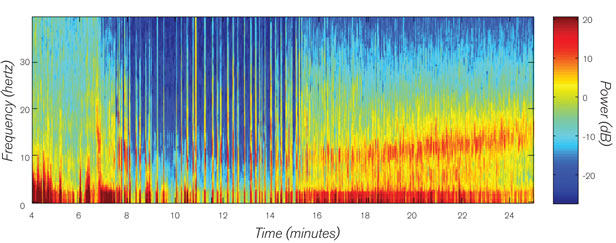The mystery behind anesthesia
December 20, 2011 | Source: Technology Review

This spectrogram shows EEG recordings from a patient undergoing general anesthesia. Two doses of the intravenous anesthetic propofol lead to bursts of activity (minute seven). Then an inhaled anesthetic, isoflurane, is added, and at minute 14, a characteristic pattern of slow-wave and alpha oscillations begins. Surgery ends at minute 16, and the isoflurane is switched off. The EEG gradually shifts to high-frequency, less intense oscillations. (credit: Emery Brown)
Mapping how our neural circuits change under the influence of anesthesia could shed light on one of neuroscience’s most perplexing riddles: consciousness.
Emery Brown, an anesthesiologist at Massachusetts General Hospital, is part of a small but growing group of anesthesiology researchers who are using the electroencephalogram (EEG), a tool for monitoring the brain’s electrical activity, to systematically probe each aspect of anesthesia in humans and animals.
Working with bioengineer Patrick Purdon and other colleagues at MGH, Brown has also developed a way to simultaneously take EEG recordings and perform fMRI scans on patients as they enter a deeply anesthetized state.
Brown, who is also a neuroscientist and professor at MIT, aims to transform anesthesia from a solely clinical tool into a powerful instrument for studying the most basic questions about the brain. Understanding what happens to the brain under anesthetic drugs, he believes, will help make anesthesia safer and more effective, with fewer side effects. It could also lead to novel treatments for coma and other brain conditions—and to insights into fundamental questions in neuroscience, including the nature of consciousness itself.
Knowing more about how the brain functions under anesthesia could also help researchers detect brain activity in people in vegetative states, revealing that they may perceive more than previously thought. The safer anesthetics that might emerge from the research could be useful in sleep medicine, and ways of reviving cognitive function in anesthetized patients might give rise to strategies for helping bring people out of comas.